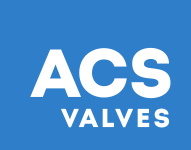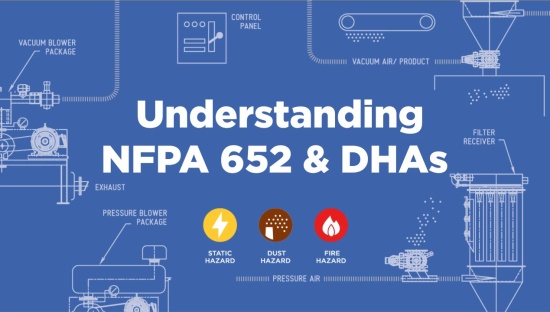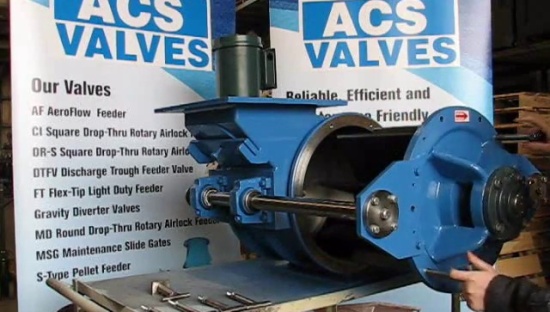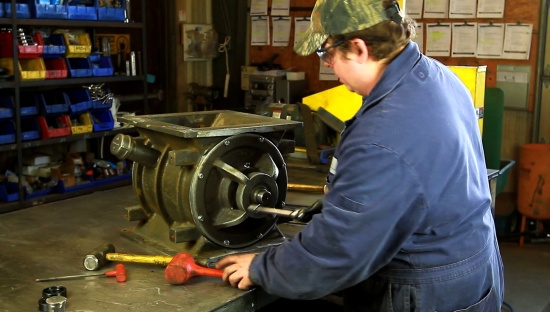What you need to know about DHAs and NFPA 652
Every material is different, and every valve has to be designed to handle each different combustible dust in order to properly prevent deflagration. Watch this video from ACS to find out what you need to know.
0:03
DHS and NFPA 652: What you need to know about DHAS and NFPA 652. Every material is different, and therefore every valve has to be designed to handle each different combustible dust in order to properly prevent deflagration. Watch this video to find out what you need to know.
0:24
"P-red" or reduced pressure is the maximum pressure developed in a vented enclosure during a vented deflagration. This is important as your rotary airlock housing, endplates, and rotor shall be of adequate strength to withstand the maximum projected explosion pressure, also known as p-red.
0:43
Every material is different and has a different potential explosion value. You must determine the value of your material being handled. As soon as you can, you should obtain a copy of NFPA 652: Standard on the Fundamentals of Combustible Dust, Edition 2016. This is super important because it is your starting point to evaluate your particulate being handled and the safety in your whole system and facility. 652 outlines the mandatory requirement for owners/operators in the facility to have DHA (dust hazard analysis) completed on each different dust their facility handles. A DHA is a dust hazard analysis.
1:23
NFPA states that this is a systematic review to identify and evaluate the potential fire, flash, or explosion hazards associated with the presence of one or more combustible particulate solid in a process or facility. It will also help determine how combustible your particulate dust is. This will determine which preventative and protective measures you will need in your systems and facility. It is important to start the process of your DHAs now, as owners/operators must schedule and complete DHAs for existing processes and facilities within three years of the date of this standard. This clock started ticking in October 2015.
2:03
Note the importance of starting this now is that you must be able to demonstrate reasonable progress in each year of the three years you have to comply. There are many reputable companies out there that can help you with your analysis and risk assessment. Don't look at it as an overwhelming task. As I said, there are great companies out there that can help you pinpoint and help you organize and prioritize which items should be addressed first for overall safety compliance. Failure to conduct a hazard analysis is a huge oversight. Don't put it off any longer.
2:36
As I said, your DHA will help you determine how combustible your particulate is. Your dust will be given a KST value. For example, there are four classes for KST values. The first has zero explosion value. An example of this would be rock dust. Class One is if your KST value is anywhere from 1 to 200. An example of this type of dust would be grain and sugar dust.
3:04
Class Two is in a range between 200 and 300. Wood dust is an example of this class, ST Class 2, i.e., wood dust. Class Three, 300 to 400, and that would be an aluminum dust. The higher the KST value, the higher the explosion risk.
3:23
Getting back to the design of the rotary valve as outlined in NFPA 69: Specific Explosion Characteristics, KST and the p-max, or maximum pressure of the powder being handled, is needed to make certain the design of the valve can handle the maximum anticipated explosion pressure. KST value plus the p-red is what determines the pressure rating required of your rotary valve.
More Videos
-
![How shear pin sprockets prevent damage to your valve]() How shear pin sprockets prevent damage to your valve
How shear pin sprockets prevent damage to your valveWatch the video to see how shear pin sprockets can help you avoid unnecessary downtime and parts replacements.
-
![Why is rotor maintenance so important?]() Why is rotor maintenance so important?
Why is rotor maintenance so important?Rotor tips wear down over time, causing issues with material flow. Our video illustrates why rotor maintenance is so critical to the overall efficiency of your rotary airlock valve.
-
![See the Multi-Port Valve at work in 3D]() See the Multi-Port Valve at work in 3D
See the Multi-Port Valve at work in 3DLearn about the features of our Multi-Port rotary airlock valve as it conveys high volumes of material in different conveying scenarios: one line, split feeds, and varying types of equipment.
-
![Steps to Clean Your Quick-Clean Rotary Valve]() Steps to Clean Your Quick-Clean Rotary Valve
Steps to Clean Your Quick-Clean Rotary ValveCleaning a Quick-Clean rotary valve is simple! This animation offers a step by step instruction on how to do it.
-
![A 3D view of material flow in an MD Series rotary airlock valve]() A 3D view of material flow in an MD Series rotary airlock valve
A 3D view of material flow in an MD Series rotary airlock valveWatch a quick 3D demonstration of material flow and pocket fill in an MD series rotary airlock valve. The video is silent.
-
![Drive Side Endplate Removal for ACST-4 Seals]() Drive Side Endplate Removal for ACST-4 Seals
Drive Side Endplate Removal for ACST-4 SealsNeed a guide to removing the drive side endplate on your ACST-4 seals? Watch a quick visual breakdown of the process. The video is silent.
-
![ACS Valves: It Will Fit]() ACS Valves: It Will Fit
ACS Valves: It Will FitOur valves will fit literally anywhere. Watch the video to find your industry.
-
![Rotor Assembly Tolerance Check]() Rotor Assembly Tolerance Check
Rotor Assembly Tolerance CheckKeep valves compliant by ensuring rotor-to-housing clearance stays below 0.0079.
-
![What you need to know about DHAs and NFPA 652]() What you need to know about DHAs and NFPA 652
What you need to know about DHAs and NFPA 652Every material is different, so every valve has to be designed to handle each combustible dust in order to prevent deflagration.
-
![Will it clean?]() Will it clean?
Will it clean?We talk a lot about how easy it is to clean our valves. Watch as we put our dinner into one of our valves and then clean it up!
-
![Yes, you have to remove our endplates to replace the shaft seal]() Yes, you have to remove our endplates to replace the shaft seal
Yes, you have to remove our endplates to replace the shaft sealWe're facing our critics head on.
-
![Understanding Airlocks: The key to increasing ROI]() Understanding Airlocks: The key to increasing ROI
Understanding Airlocks: The key to increasing ROILearn the fundamentals of airlock performance, how to minimize air leakage and how improve efficiency.
-
![How to convey sticky material with a blow-through]() How to convey sticky material with a blow-through
How to convey sticky material with a blow-throughWhen conveying sticky material, you can get the benefits of a blow-through without the premature wear.
-
![Why you can't afford an unreliable valve]() Why you can't afford an unreliable valve
Why you can't afford an unreliable valveChoosing the right rotary valve can improve your productivity. Choosing the wrong one can do the opposite.
-
![Make cleaning suck less with our Quick-Clean valve on RotorRails™]() Make cleaning suck less with our Quick-Clean valve on RotorRails™
Make cleaning suck less with our Quick-Clean valve on RotorRails™Cleaning is the worst! Make it better. Watch this video to learn how.
-
![See the Quick-Clean valve in all its glory]() See the Quick-Clean valve in all its glory
See the Quick-Clean valve in all its gloryComplex in design but simple to operate, this glamorous valve model has some serious performance to back it up.
-
![Aero-Flow Pneumatic Rotary Feeder Valve]() Aero-Flow Pneumatic Rotary Feeder Valve
Aero-Flow Pneumatic Rotary Feeder ValveA feeder valve for sticky and abrasive materials combines pressurized air with the dry bulk material.
-
![Quick-Clean Rotary Valve Demonstration]() Quick-Clean Rotary Valve Demonstration
Quick-Clean Rotary Valve DemonstrationEnables quick, tool-less access to the rotor and the interior of the housing for cleaning.
-
![ACS Valves Rotary Airlock Valve Test Center]() ACS Valves Rotary Airlock Valve Test Center
ACS Valves Rotary Airlock Valve Test CenterOur test center is designed to test your materials to determine which airlock valve/feeder is best suited for your application.
-
![ACS Valves Quick Clean Feeder - Pellet Feeder]() ACS Valves Quick Clean Feeder - Pellet Feeder
ACS Valves Quick Clean Feeder - Pellet FeederACS Valves Quick Clean Feeder on Rails is designed for quick take apart applications.
-
![Quick-Clean Rotary Valve]() Quick-Clean Rotary Valve
Quick-Clean Rotary ValveThis valve can be taken apart, cleaned and reassembled in just minutes hassle free!
-
![ACS Quick-Clean Airlock/Feeder]() ACS Quick-Clean Airlock/Feeder
ACS Quick-Clean Airlock/FeederThe Quick Clean feeder is easy to disassemble and reassemble, in as little as 2 minutes.
-
![ACS Valves Standard Valve Assembly]() ACS Valves Standard Valve Assembly
ACS Valves Standard Valve AssemblyThis simple rotary valve re-assembly sequence shows the significant labor and downtime savings associated with this rotary valve design
-
![ACS Valves Airlock Testing Process]() ACS Valves Airlock Testing Process
ACS Valves Airlock Testing ProcessEach rotary valve goes through a thorough inspection process before leaving ACS.
-
![ACS Valves CNC Turning Center]() ACS Valves CNC Turning Center
ACS Valves CNC Turning CenterACS Valves production operations include casting of rotary valve housings and the CNC machining of the housings.
-
![ACST-4 Glandless Shaft Seal versus Packing Gland Seals]() ACST-4 Glandless Shaft Seal versus Packing Gland Seals
ACST-4 Glandless Shaft Seal versus Packing Gland SealsEliminates the need for conventional packing gland-style shaft seals.
-
![ACST-4 Glandless Shaft Seal Removal Sequence]() ACST-4 Glandless Shaft Seal Removal Sequence
ACST-4 Glandless Shaft Seal Removal SequenceACST-4 Glandless Teflon Shaft Seal can be easily removed and reassembled in just a few minutes using basic hand tools.
-
![ACS Valves Vertical CNC Machining Center]() ACS Valves Vertical CNC Machining Center
ACS Valves Vertical CNC Machining CenterProduction operations include CNC machining of rotor blades, rotor adjustable tips, slide-gate parts, inspection panels, and metering-s
Go ahead, make your valve
Put your own spin on our customizable valves to get the best valve for your application, material and industry.

This year’s most popular rotary valve topics
In 2025, our readers enjoyed learning about NFPA 660, shear pin sprockets, signs a valve needs attention, and valves for pneumatic conveying.




























